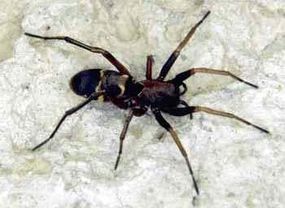Quck answer
Spiders are arachnids that belong to the order Araneae. They have two main body parts, eight legs, and multiple eyes. Spiders use their legs and silk to move around and catch prey. They have special glands that produce silk, which can be used for many purposes, including creating webs to catch prey, making egg sacs, and building shelters. Spiders also have venomous fangs that they use to paralyze their prey. Once the prey is paralyzed, the spider injects digestive enzymes into the prey’s body and sucks out the liquefied contents. Despite their reputation for being creepy and dangerous, most spiders are harmless to humans and play an important role in controlling insect populations.
Wildlife
Spider Shedding

Aculepeira armida, an orb web spider
Photo courtesy Ed Nieuwenhuys
Spiders, like humans, move by contracting muscles that are connected to a skeleton. But unlike humans who have an internal skeleton, spiders have an exoskeleton – a stiff support structure on the outside of their body. The segments of the exoskeleton are connected to joints, which allow the spider to move its body parts back and forth.
When the muscles attached to the inside of the exoskeleton contract, the spider’s legs move inward. However, spiders do not have muscles to extend their legs back out. Instead, they need to force bodily fluids like blood into their legs to push them outward. If they lose too much body water, they cannot generate the necessary hydraulic pressure to push their legs out. This is why you may sometimes see spiders on their backs with their legs curled up.
The cuticle, a composite material containing various proteins and chitin, a long-chain polysaccharide (sugar), makes up the exoskeleton’s several layers. The protein and chitin molecules are arranged in successive layers like the grain in plywood. This structure makes the cuticle strong and highly effective at preventing the spider from drying out. However, it cannot expand like human bones and tissue, making it impossible for spiders to grow. To increase their size, spiders must form a new and larger cuticle exoskeleton and shed the old one – a process referred to as molting.
Spiders molt frequently when young, and some species may continue to molt throughout their life. Hormones signal the spider’s body to absorb some of the lower cuticle layer in the exoskeleton and begin secreting cuticle material to form the new exoskeleton. The new exoskeleton is often folded to some extent, so it can expand when the spider sheds the older one. The spider also secretes molting fluid between the old and new exoskeletons. Once the new exoskeleton is finished, the spider absorbs the molting fluid, creating a gap between the two exoskeletons, which makes it easier to separate them.

Micaria romana: Although these spiders have eight legs and two body segments, they resemble their primary prey, ants.
To shed the old exoskeleton, the spider must break out from the inside. It increases its heart rate to pump hemolymph (the spider’s blood) from the abdomen into the cephalothorax. The pressure expands the cephalothorax, which pushes on the old exoskeleton until it cracks. The spider then flexes its muscles until the old exoskeleton falls away.
After shedding the old exoskeleton, the spider does most of its growing while the new exoskeleton is highly flexible. In this stage, the new exoskeleton is also very soft, which makes the spider particularly vulnerable to attack. Many species will lower themselves on a silk line during the molting process so they are out of reach of predators while the cuticle material hardens.
FAQ
1. What are spiders and how do they differ from insects?
Spiders are arachnids, not insects. They have two main body parts, eight legs, and no wings or antennae. Unlike insects, spiders have fangs and venom, which they use to catch and kill their prey.
2. How do spiders spin webs?
Spiders spin webs using silk, which is produced in their bodies. They have special glands that create different types of silk for different purposes. A spider will use its legs to pull the silk out of its spinnerets and then mold it into the shape of a web. Some spiders build webs to catch prey, while others use silk to make egg sacs or to create shelter.
3. How do spiders hunt for food?
Spiders use a variety of methods to hunt for food, depending on their species and environment. Some spiders build webs to catch insects, while others actively hunt for prey by stalking or ambushing. Some spider species even use camouflage to blend in with their surroundings and surprise their prey.
4. How do spiders reproduce?
Spiders reproduce sexually, with males depositing sperm into the female’s reproductive system. Females then lay eggs, either in an egg sac or directly onto a surface. Spider mothers may guard their eggs or young, or they may abandon them to fend for themselves.
5. Are all spiders venomous?
No, not all spiders are venomous. In fact, only a small percentage of spider species are considered dangerous to humans. However, it’s important to be cautious around all spiders, as even non-venomous ones can bite and cause an allergic reaction or infection.
6. How do spiders molt?
Spiders molt, or shed their exoskeleton, in order to grow. They will spin a special mat of silk to help them grip a surface and then split their old exoskeleton, emerging with a new, larger one. Molting is a vulnerable time for spiders, as they are soft and defenseless until their new exoskeleton hardens.





Leave a Reply